Sounds of Titan
A space probe touches down on an alien, but eerily familiar world and samples its music.
By Emily Sohn
Visiting a mysterious, alien world is usually just the stuff of dreams or science fiction stories. For many scientists around the world, the dream came true last month when a space probe touched down for the first time on the frigid, sculpted surface of Saturn’s moon Titan.
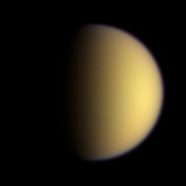 |
|
This image of Titan, taken by the Cassini spacecraft soon after it reached Saturn, shows the orange haziness for which the moon is famous.
|
| NASA/JPL/CICLOPS |
The Cassini-Huygens mission to Saturn and Titan has been on the road for more than 7 years. Last June, the spacecraft finally reached the ringed planet and went into orbit around it to take pictures and collect data (see “Ringing Saturn” at http://www.sciencenewsforkids.org/articles/20040728/Feature1.asp and “Saturn’s New Moons” at http://www.sciencenewsforkids.org/articles/20040825/Note3.asp ).
In December 2004, Cassini released the Huygens probe, and the probe arrived on the surface of Titan several weeks later. Huygens surpassed all expectations, delivering the first intimate pictures of the enigmatic moon, long shrouded in haze (see “Unveiling Titan” at http://www.sciencenewsforkids.org/articles/20050126/Note2.asp ).
It was an exciting time for scientists and engineers tracking the probe. “We . . . were transfixed as the images flickered across the computer screen, the haze slowly cleared, and more and more features showed through,” says Mike Bushroe of the University of Arizona. He’s a member of the Huygens probe camera team.
 |
|
The Huygens probe landed on Titan in a field of rocks and pebbles. The large object just below the middle of the image is about 15 centimeters (about 6 inches) across. The surface appears to consist of a mixture of water ice and hydrocarbon ice.
|
| ESA/NASA/Univ. of Arizona |
After the probe landed, the many surface images showed what looked like a gravel-strewn, dry riverbed. It looked “like the washes near my home in Tucson,” Bushroe says. “More than any other planet that we have seen the surface of, Titan looks like you could just step through the picture and recognize all the terrain around you.”
What you may not know is that Huygens also carried a special kind of microphone. For a few hours as the probe plunged toward Titan, then landed and sat on its surface, it collected sounds and relayed them to its mother craft, along with photographs and data about the moon’s atmosphere and soil. Cassini sent the information on to Earth.
Scientists are still trying to work out what all the recorded noises mean. In the meantime, you can listen to the sounds of Titan on the Internet, at planetary.org/sounds/huygens_sounds.html (Planetary Society).
More than static
Capturing the sounds of Titan is a remarkable achievement, says planetary scientist Bruce Betts. He’s director of projects at the Planetary Society. The organization, located in Pasadena, Calif., is interested in getting the public excited about space exploration.
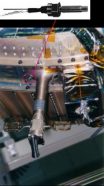 |
|
The Huygens microphone is a tiny instrument that sticks out from a short boom that also holds sensors for measuring temperature and pressure during the probe’s descent through Titan’s atmosphere.
|
| HASI-PWA Team, ESA/ASI/UPD/IWF |
“This is something that’s never been done before,” Betts says. Until now, the main way people had for learning about other planets or moons was by monitoring data from instruments or looking at pictures taken by telescopes and spacecraft. “For the first time, we get to experience another world through one of our other senses,” he says.
Personal experiences, such as listening to alien sounds, are essential for getting people to care about space, Betts says. “It really gives us another feeling for these other worlds, which seem so distant and unreal at times,” he says. “This is a huge step forward in space exploration.”
Excited about what I might hear, I listened to Titan. “It sounds like static to me,” I told Betts. I don’t know what I had been expecting, but I was disappointed.
Betts laughed. He then explained that the microphone was on the outside of Huygens. As the probe fell through Titan’s atmosphere, it detected the sound of air rushing by—a kind of wind. It’s like the sound you would hear if you stuck your head out of the window of a moving car (but don’t try that yourself). After the probe landed, the transmissions were much quieter.
“The sound itself isn’t exciting,” Betts admits. “But it’s a real sound. You’re actually hearing something a billion miles away.”
Analyzing clunks
Besides inspiring people to learn more about Saturn and its many moons, the sounds themselves may also teach astronomers a thing or two, Betts says. Analyzing the wind sounds, for example, could suggest how thick Titan’s atmosphere is.
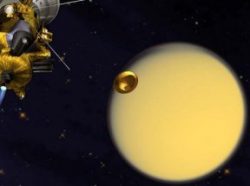 |
|
This illustration shows the Huygens probe (middle) separating from the Cassini spacecraft (left) before entering Titan’s murky atmosphere.
|
| NASA/JPL |
From the way Huygens landed, clunks and scrapes could provide information about the texture of the ground. And other noises might give spacecraft engineers insights into what the probe’s instruments did and how well they worked.
So far, researchers haven’t detected any traces of thunder in the soundtrack. If they had, this would have told them something interesting about weather patterns on the moon.
If they had heard gurgling, this would have been interesting, too. Pictures of Titan show shorelines and channels, signs of a geologically active place. But the moon is very cold, and scientists don’t know if there’s any liquid methane or ethane flowing on it today.
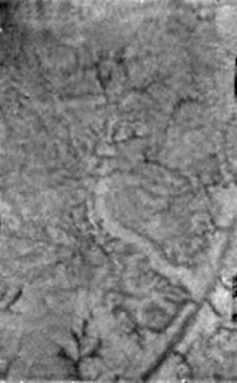 |
|
This Huygens image shows short, stubby, dark channels, which may have been formed by springs of liquid methane rather than methane rain.
|
| ESA/NASA/University of Arizona |
Titan looks a lot like early Earth, but neither pictures nor sounds picked up signs of life. “You don’t hear people walking,” Betts says. “There are no animals. You don’t hear anyone yelling, ‘Get off me!'” Scientists would surely have been shocked to hear something like that.
Still, no one knows what more we would have heard if Huygens had been able to send additional data back to Cassini.
It also would have been interesting, Betts says, to collect sounds from a wider area. So much of what you hear depends on where you land. Think about what Earth would sound like if you landed on a beach. Then compare this to what you would hear in a rainforest or on the side of a volcano.
The sounds that did come through were collected by a microphone that was wired to a computer onboard Huygens. To save space and power during the short window of communication time, Huygens sent small packets of data describing the sounds rather than the sounds themselves.
Our ears, however, pick up sounds of many frequencies over a continuous period of time. So, interpreting the data involves stretching the information back into a form that makes sense to our ears and brains. There’s still more analysis to do, and scientists might eventually extract additional details.
The Huygens probe also brought its own music to Titan. The craft carried a recording of four musical themes, written by French musicians Julien Civange and Louis Haéri. You can hear the music at music2titan.com/ (Silkwood Music).
Other senses
The Planetary Society hopes someday to be able to compare Titan’s sounds with sounds from other moons and planets that have atmospheres. (Sound can’t travel without an atmosphere to transmit it. In fact, most of outer space, including Earth’s moon, is airless and completely silent.)
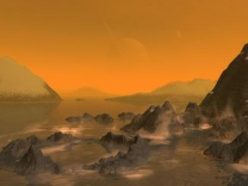 |
|
An artist’s impression of Titan’s daytime surface.
|
| NASA/JPL, Stan Richard, Des Moines, Iowa |
The organization had put a microphone on the Mars Polar Lander, but this mission failed to reach its destination. On Mars, sounds might include dust storms, blowing sand, and electrical discharges. On Jupiter, a microphone might catch one of the planet’s many lightning storms.
It may also be possible to go beyond sight and sound to experience another planet or moon. Touch will probably be next, Betts says. Before space travel becomes a realistic way to explore the solar system, computer simulations and virtual reality could give us a sense of feel for another planet.
Smell is a tough one. Some instruments already work like “sniffers” to analyze the chemical composition of an atmosphere. But that’s not really the same as smelling something. Maybe it’ll be possible someday to put together here on Earth the same mixture of chemicals found on a distant moon, then get a whiff of this other world—as long as the gases aren’t toxic!
Taste could be even tougher and riskier. Who wants to lick a rock?
There are many ways to experience the universe. Some are certainly more pleasant than others. For now, though, I think I’d stick with sight and sound!
Going Deeper:







